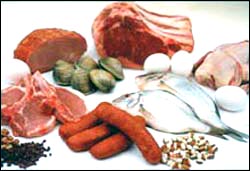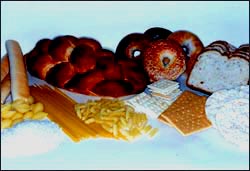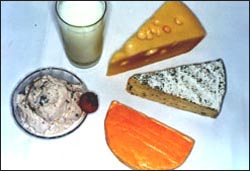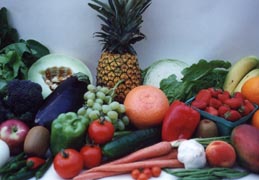소아청소년들의 예측 체중·신장와 예측 체중·신장 증가치, Predictive value of weight and height and weight-height gaining for age in children and adolescents
신생아들, 영유아들, 학령기 전 유아들, 학령기 아이들, 사춘기 아이들의 체중 증가
- 평균 출생체중은 3.3Kg이다.
- 만삭에 태어난 신생아들의 체중은 생후 10일 경에 출생 시 체중으로 돌아가는 것이 보통이다.
- 만삭에 태어난 생후 5개월 영아들의 체중은 출생 시 체중의 배가 되는 것이 보통이다.
- 만삭에 태어난 1세 영아들의 체중은 출생 시 체중의 3배 정도 된다.
- 생후 5~6개월까지 대부분의 영아들의 체중은 1일 약 15~20gm, 또는 약 20~30gm 정도 증가되고
- 생후 6~12개월 동안, 대부분의 영아들의 체중은 1일 약 10~20gm 정도 증가한다.
- 대부분의 3세 유아들의 체중은 출생 시 체중의 4배정도 된다.
- 대부분의 5세의 학령전기 아이들의 체중은 출생 시 체중의 5배정도 된다.
- 대부분의 7세의 학령기 아이들의 체중은 출생 시 체중 7배정도 된다.
- 대부분의 10세의 학령기 아이들의 체중은 출생 시 체중의 10배정도 된다.
- 대부분의 15세의 사춘기 아이들의 체중은 출생 시 체중의 15배정도 된다.
- 그 영아가 생후 4~6개월이 되었을 때 체중은 6kg 정도 된다고 예측할 수 있다.
- 대부분의 영아들이 건강하게 계속 정상적으로 자라서 첫 돌이 될 때 체중은 출생 시 체중의 세(3) 배가 된다. 즉 그 영아가 첫 돌이 될 때의 체중은 9kg가 될 것이다.
- 그 자녀는 태어나서 첫 돌이 될 때까지 첫 1년 동안 약 6kg 정도 체중이 증가된 셈이다.
- 그 아이의 체중이 생후 첫 1년 동안 증가 됐던 속도와 거의 같은 속도로 앞으로 계속 증가된다면(즉, 매년 체중이 6kg 증가 된다면) 그 아이가 10세가 될 때 체중은 계산상으로 63kg 정도 될 것이다.
- 11세가 될 때 체중은 계산상으로 69kg 정도 된다. 즉 11세의 체중은 성인의 체중과 거의 비슷하게 된다고 예측할 수 있다.
- 그러나 그 아이의 정신 연령은 체중 치 성장에 비례해 정상적으로 발육되지 않는 것이 보통이다.
- 아이가 태어나서 첫 돌까지 성장하는 속도와 비슷한 성장 속도로 10세가 될 때까지 계속 성장한다면 그 아이의 육체적 성장과 정신적 발육에 균형을 잃게 되고 가정에서나 학교 사회에서 문제아가 될 수 있고 건강상 문제아가 될 수 있다.
- 모든 아이들은 앞서 설명한 것 같이 성장 발육되지 않는 것이 정상이다.
- 특히 첫 돌이 지난 이후부터 사춘기가 시작되기 전까지 기간 동안 거의 모든 아이들의 체중과 신장의 성장 속도는 첫 돌 이전 성장속도에 비해서 아주 느린 것이 정상이다.
- 다시 말하면, 태어나서 첫 돌까지 성장 속도는 상당히 빠르고 첫 돌이 지난 이후부터 사춘기가 시작되기 전까지 성장 속도는 상당히 느린 것이 정상적이다.
- 첫 돌 때부터 2세가 될 때까지 1년 동안 체중 증가는 2~4kg 정도이다.
- 어떤 아이는 첫 돌부터 2세까지 1년 동안 체중 증가는 약 2kg 정도이다.
- 거의 모든 유아들은 2세 이후부터 사춘기가 시작되기 전까지 정상적으로 체중이 조금씩 증가된다.
- 이 기간 동안 체중이 하루 평균 10g정도 증가되고 1년 동안 체중이 정상적으로 2~4kg 정도 증가된다.
- 자연 섭리에 따라 사춘기가 시작하기 전 시상하부에서 분비되는 성장 호르몬 분비억제 호르몬(소마토스타틴)의 영향으로 성장 호르몬 작용 억제가 생기고 그로 인해 소아 성장이 적절히 조절된다. 소마토스타틴 호르몬에 감사를 드린다.
- 그 유아, 사춘기 전 학령기 아이의 체중이 하루에 10g 정도 증가되면서 앞서 설명한 것같이 정상적으로 계속 성장하기 위해 먹을 수 있는 음식물의 종류와 양이 그 아이의 정상적이고 특이 체중 증가 속도에 맞추어 나간다.
- 아이의 나이에 따른 정상 특이 성장 발육의 정도에 따라 아이가 먹는 음식물의 종류와 양이 대략 조절된다.
- 첫 돌 이후부터 사춘기가 되기 전까지 상당히 활동적이고 운동을 많이 하는 아이들은 그날그날 하는 육체적 운동량과 활동량에 따라 칼로리 양을 소모한다.
- 그 소모된 칼로리 양을 보충하기 위해 더 많은 칼로리 양이 필요하다.
- 그 때문에 아이들은 음식물을 더 많이 먹게 된다. 그와 반대로 육체적 운동을 적게 하고 육체 활동량이 적은 아이들은 음식물을 덜 먹게 된다. 다시 말하면 여기서도 수요공급 원칙이 적용된다.
- 매일 먹는 음식물에서 얻은 칼로리 양의 대부분은 그날그날 육체적 운동을 하는데 필요한 에너지 자원으로 소비되고, 일부는 성장 발육하는 데 쓰인다.
- 나머지 칼로리는 그때그때 필요에 따라 쓰기 위해 몸속에 저장될 것이다.
| 소아청소년들 예측 평균 신장을 계산하는 공식
7∼12세 아이의 예측 평균 신장= 나이(년) x 6+ 77 |
소아 예측 평균 체중을 계산하는 공식
|
정상적으로 성장하는 소아청소년들의 정상 체중 증가에 관한 예
|
소아청소년들 예측평균 신장 계산 공식
|

그림 1-93. 단백질류 음식물과 지방질 류 음식물 중 한두 가지 음식물을 적절히 섭취한다.
Copyright ⓒ 2011 John Sangwon Lee, MD., FAAP

그림 1-92. 탄수화물류 음식물 중 한두 가지 음식물을 충분히 섭취한다.
Copyright ⓒ 2011 John Sangwon Lee, MD., FAAP

그림 1-95. 체질에 맞으면 우유나 우유 음식물 류를 충분히 섭취한다.
Copyright ⓒ 2011 John Sangwon Lee, MD., FAAP

그림 1-94. 채소류 음식물과 과일류 음식물 중 한두 가지를 충분히 섭취한다.
Copyright ⓒ 2011 John Sangwon Lee, MD., FAAP
Predictive value of weight and height and weight-height gaining for age in children and adolescents
Weight gain in newborns, infants, preschool children, school-age children, and adolescents
• The average birth weight is 3.3 kg.
• The weight of newborns born at full term usually returns to their birth weight around the 10th day of life.
• It is common for 5-month-old infants born at full term to weigh twice as much as their birth weight.
• One-year-old infants born at full term weigh about three times their birth weight.
• By 5-6 months of age, most infants gain about 15-20 gm per day, or about 20-30 gm per day.
• During 6 to 12 months of age, most infants gain about 10 to 20 gm per day.
• Most 3-year-olds weigh four times their birth weight.
• Most pre-school children aged 5 years weigh five times their birth weight.
• Most 7-year-old school-age children weigh seven times their birth weight.
• Most 10-year-old school-age children weigh 10 times their birth weight.
• Most 15-year-old adolescents weigh about 15 times their birth weight.
• When the infant is 4 to 6 months old, it can be predicted that the infant will weigh about 6 kg.
• Most infants are healthy and continue to grow normally, weighing three (3) times their birth weight by the time they reach their first birthday. That is, the infant will weigh 9 kg at the first birthday.
• The child gained about 6 kg in the first year from birth to the first birthday.
• If the child’s weight continues to increase in the future at about the same rate that it gained during the first year of life (ie, gain 6 kg each year), the child will weigh approximately 63 kg by the time he is 10 years old.
• When she turns 11, she weighs approximately 69 kg. In other words, it can be predicted that the weight of an 11-year-old will be almost the same as that of an adult.
• However, the child’s mental age usually does not develop normally in proportion to weight growth.
• If a child continues to grow until the age of 10 at a rate similar to that from birth to the first year of life, the child’s physical and mental development will be out of balance, and he or she may become a problem child at home or in school, and a child with health problems. can be • It is normal for all children to not grow and develop as described above.
• It is normal that the growth rate of weight and height of almost all children is very slow compared to the growth rate before the first birthday, especially after the first birthday and before the onset of puberty.
• In other words, it is normal for the growth rate to be quite fast from birth to the first birthday and to be quite slow from the first birthday to the onset of puberty.
• From the first baby to the age of 2 years, the weight gain is about 2-4 kg.
• Some children gain about 2 kg of weight in one year from their first birthday to the age of two. • Almost all infants gain a little weight normally from the age of two until the onset of puberty.
• During this period, the body weight increases by an average of 10g per day, and the weight normally increases by 2~4kg per year.
• According to the natural providence, growth hormone secretion inhibitory hormone (somatostatin) secreted from the hypothalamus before puberty causes inhibition of growth hormone action, thereby regulating child growth. Thanks to the somatostatin hormone.
• As the infant and pre-pubertal school-age child gain about 10g per day, the type and amount of food they can eat to keep growing normally, as described above, match the child’s normal and specific weight gain
. • The type and amount of food a child eats is roughly controlled according to the level of normal specific growth and development according to the child’s age.
• Children who are very active and athletic from their first birthday through puberty burn calories based on the amount of physical exercise and activity they do each day.
• You need more calories to make up for the amount of calories burned.
• This causes children to eat more. Conversely, children who are less physically active and less physically active eat less food. In other words, the supply-demand principle applies here as well.
• Most of the amount of calories you get from the food you eat each day is consumed as an energy resource for your daily physical exercise, and some is used for growth and development.
• The rest of the calories will be stored in the body for use on an as-needed basis.
Formula to calculate the predicted average height of children and adolescents
Predicted average height for children aged 7 to 12 = age (years) x 6+ 77
Formula to Calculate Predicted Mean Weight for Children
• Weight (kg) of girls 3-12 months = [age (months) + 9]/2
• Weight (kg) of children aged 1-6 = Age (years) x 2 + 8
• Weight of children aged 7-12 years (kg) = [age (years) x 7 – 5)]/2
Examples of normal weight gain in children and adolescents growing normally
• Assume that a full-term baby weighs 3 kg at birth.
• It is normal for most infants born at full term to weigh 4 to 6 months of age at twice their birth weight.
The formula for calculating average height for children and adolescents
• Most infants grow an average of 25-30 cm in height during the first year of life.
• Predicted height of an adult male (cm) = (Mom’s height + Dad’s height)/2 + 5cm
• Predicted height of an adult woman (cm) = (Mom’s height + Dad’s height)/2 – 5 cm
• A 2-year-old child is half the height of an adult.
• Predicted height for an adult male (cm) = 1.27 x height at age 3 + 54.9
• Adult female height (cm) = 1.29 x 3 year old + 42.3

Figure 1-93. Eat one or two of protein foods and fatty foods appropriately. Copyright ⓒ 2011 John Sangwon Lee, MD., FAAP

Figure 1-92. Eat enough of one or two of the carbohydrate foods. Copyright ⓒ 2011 John Sangwon Lee, MD., FAAP

Figure 1-95. If it suits your constitution, consume enough milk or milk foods. Copyright ⓒ 2011 John Sangwon Lee, MD., FAAP
V
Figure 1-94. Eat enough of one or two vegetable and fruit foods. Copyright ⓒ 2011 John Sangwon Lee, MD., FAAP
출처 및 참조 문헌 Sources and references
- NelsonTextbook of Pediatrics 22ND Ed
- The Harriet Lane Handbook 22ND Ed
- Growth and development of the children
- Red Book 32nd Ed 2021-2024
- Neonatal Resuscitation, American Academy of Pediatrics
- The Johns Hopkins Hospital, The Harriet Lane Handbook, 22nd edition
- Red book 31st edition 2021
- Nelson Text Book of Pediatrics 21st Edition
- Infectious disease of children, Saul Krugman, Samuel L Katz, Ann A. Gershon, Catherine Wilfert
- Emergency Care Transportation of Sick and Injured American Academy of Orthopaedic Surgeons
- Emergency Pediatrics A Guide to Ambulatory Care, Roger M. Barkin, Peter Rosen
- Gray’s Anatomy
- Ambulatory Pediatrics, Green and Haggerty, Saunders
- Introduction to Clinical Pediatrics, Smith and Marshall, W.B. Saunders Co
- School Health: A Guide For Health Professionals, American Academy of Pediatrics
- Holly Bible
- How to really love your child Ross Campbell
- Good Behavior Stephen W. Garber, Ph.D. and other
- Kids Who follow, Kids who don’t
- Loving Each Other Leo F Buscaglia, Ph, D.
- Guide to Your Child’s Sleep. American Academy of Pediatrics
- Hematology and Oncology in Adolescence, Neil J. Grossman, M.D., Stuart S. Winter, M.D., Adolescent Medicine, and The Media Adolescents Medicine
- AM: Stars Adolescent Medicine: State of the Art Reviews, Asthma, and Diabetes in Adolescents, Robert A. Wood, M.D., Samuel J. Casella, M.D. April 2010, AAP
- AM: Stars Adolescent Medicine: State of the Art Reviews, Sleep and Sleep Disorders in Adolescents, Amy E. Sass, M.D., MPH, David W. Kaplan, M.D., MPH Editors December 2010, AAP
- The Pediatric Clinics of North America, Adolescent Gynecology, Part II THe Sexually Active Adolescent, August 1999
- The Pediatric Clinics of North America, Childhood and Adolescent Obesity, August 2001
- Adolescent Dermatology, Daniel P. Krowchuk, M.D., Anne W. Lucky, M.D., Adolescent Medicine, 12:2 June 2001
- Gastrointestinal Disorders, Jeffrey S. Hyams. M.D. Editor, Adolescent Medicine
- Fueling the Teen Machine, Ellen Shanley and Colleen Thompson
- Why Teenagers Act the Way They Do, Eight Adolescent Personality Types: Understanding and Dealing With Them, Dr. G. Keith Olson
- Adolescent Psychiatry, Adolescent Medicine Clinics, Feb. 2006 Vol 17 #1 Richard E. Kreipe, M.D., Christopher H. Hodgman, M.D.
- Adolescent and the Media, Adolescent Medicine Clinics June 2005 Vol 16 #3, Guest Editors: Victor C. Strasburger, Marjorie J. Hogan, M.D.
- 진정한 자녀 사랑 나비게이터
- 10대 아들 딸 이렇게 사랑해 키워라 이상원 역저 (How to really love your teenager. Ross Campbell MD)
- 소아과학 대한교과서
- 의학 용어사전 대한 의사 협회
- 그 외
Copyright ⓒ 2014 John Sangwon Lee, MD., FAAP
“부모도 반의사가 되어야 한다”-내용은 여러분들의 의사로부터 얻은 정보와 진료를 대신할 수 없습니다.
“The information contained in this publication should not be used as a substitute for the medical care and advice of your doctor. There may be variations in treatment that your doctor may recommend based on individual facts and circumstances.
“Parental education is the best medicine.